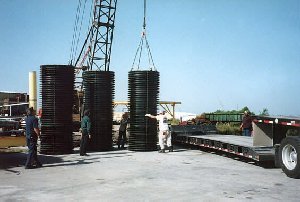E.P.I. Floatover System Design
| E.P.I.'s engineering staff has developed an intensive design and testing procedure to develop floatover installation systems. Through a rigorous system of compound analysis, small scale testing, and finite element analysis (FEA), we are able to accurately predict the performance of a full scale shockcell system. | |
| E.P.I., in conjunction with some of the premier rubber compound developers in the world, can perform a variety of tests to determine the feasibility and function of a design. These tests include small scale static and dynamic tests, environmental exposure tests, creep and compression set tests, material strength tests, and many others, including full scale tests. | |
 |
E.P.I. has designed floatover systems for installing decks in excess of 12,000 tons. A single leg mating unit in this system was approximately 12 feet tall, 5 feet in diameter, and was capable of sustaining loads in excess of 4500 tons. The units were tested under cyclic loading with a period of 12 seconds with no hysteresis observed. This simulates the wave action of the barge during installation. The elastomer units were able to withstand an environment of seawater, high ambient temperature, and high humidity. They also had a creep settlement value of less than 2% over a twelve week sustained load. E.P.I. was able to test full scale units to 3000 tons. |
If this page does not appear in a frame, click here to go to E.P.I.'s Home Page.
This page designed and maintained by E.P.I.
© 2000, E.P.I.
Questions and Comments to: sales@app-epi.com